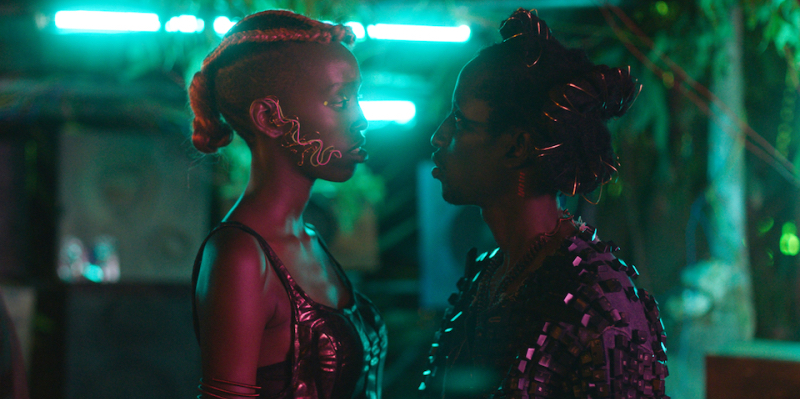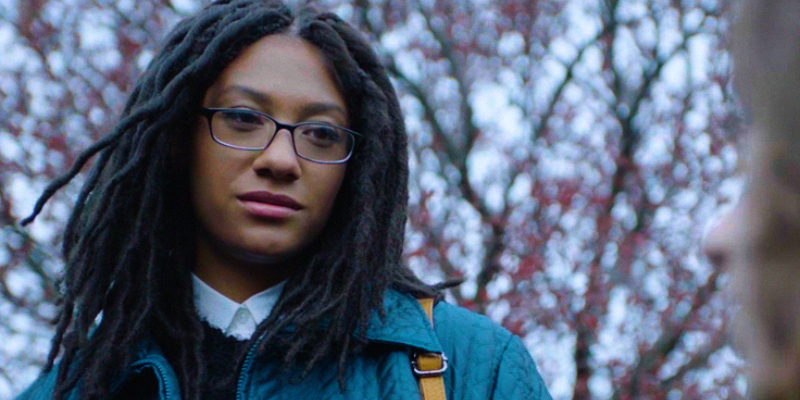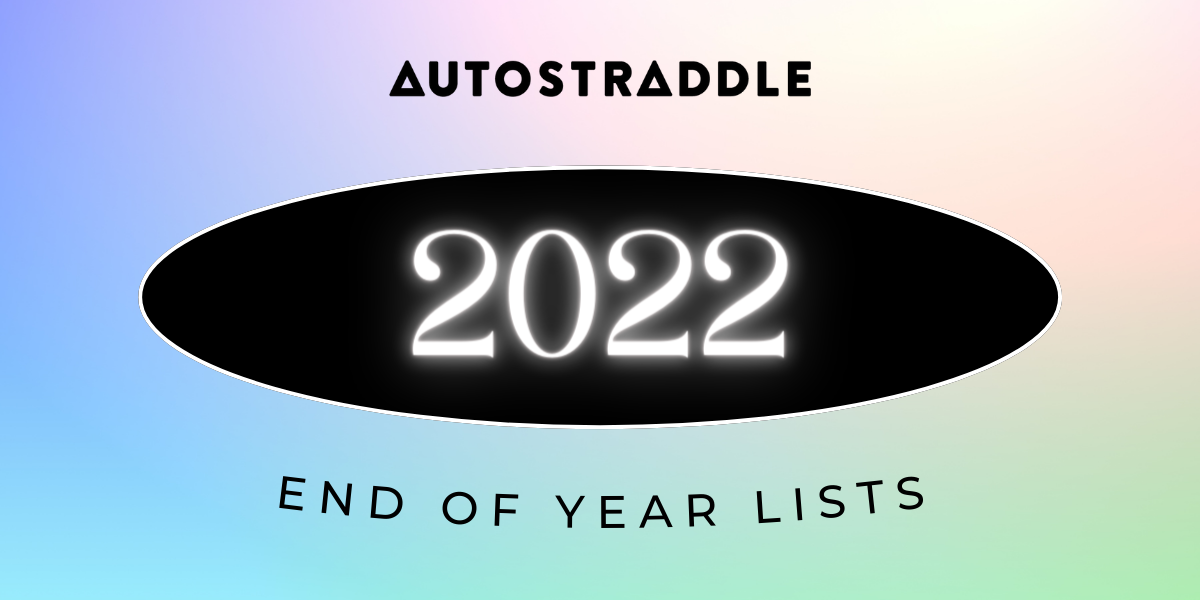Since I started writing at Autostraddle, my best movies of the year list aimed to mention every queer or lesbian movie — good or bad — to show just how many of our films are made each year. Well, it finally happened. There are finally too many.
I’ve tried to see as much as possible but I simply can’t see them all. What an exciting development! This year is also exciting because my queer list is almost identical to my general list. With the exceptions of Nanny and The Pink Cloud, the movies that moved me most this year were queer. And the movies that moved our culture were too.
Yes, this list has some underrated indies. But it also has several Oscar frontrunners — or at least Independent Spirit Award frontrunners. As queer people, we can’t look to the mainstream for validation. But it sure is fun when we get it anyway!
It’s also exciting to me that many of these films go beyond our conventional understanding of a queer movie. For many of these films, queerness is included and centered, but the conventions are not. There’s a difference between queerness not being the point and queerness being the point in totally new ways.
This list used to only be about lesbian cinema but this year we’ve expanded it to encompass all queer and trans cinema! There were just too many exciting works of trans art to leave them out.
Yes, we say best for those sweet list clicks — and because I have impeccable taste — but these are just my faves! I encourage you to comment what your favorite queer movies were this year and let me know what I might have missed.
Honorable Mentions
Anaïs in Love (dir. Charline Bourgeois-Tacquet)
Crush (dir. Sammi Cohen)
Dos Estaciones (dir. Juan Pablo González)
Fire Island (dir. Andrew Ahn)
Girl Picture (dir. Alli Haapasalo)
Mija (dir. Isabel Castro)
Nothing Compares (dir. Kathryn Ferguson)
Please Baby Please (dir. Amanda Kramer)
Sirens (dir. Rita Baghdadi)
TÁR (dir. Todd Field)
Wendell and Wild (dir. Henry Selick)
A Masterpiece That Is Kind Of Gay and Kind Of Came Out This Year
Petite Maman (dir. Céline Sciamma)
Okay so most people counted genius lesbian auteur Céline Sciamma’s latest on last year’s film lists even though it had its main release this past May. It’s also not really a queer movie even if I do think it has a queerness to it beyond its writer/director. Anyway, it’s not included because of these technicalities, but I still wanted to give it a shoutout because it’s a gem of a movie — narrow in scope, vast in feeling.
The Top Ten
10. Death and Bowling (dir. Lyle Kash)

During a time when Hollywood seems uncertain about their support of trans stories, I can think of no better film to start off this list than Lyle Kash’s low-budget t4t fantasia. Whether or not society wants us to die, trans people will live. Whether or not the mainstream finances our work, trans artists will create. Kash’s film about a struggling trans actor begins as if it’s going to confront these questions head-on. But then it shifts. It becomes less about cis perception of trans people and more about our relationships to ourselves and each other. Friends, lovers, mentors, family. Our grief and our romance held in equal esteem. This is the kind of queer movie I was raised on. I dream of trans creators getting big budgets, but I will always have a fondness for work that is this scrappy and this formally confident.
9. Neptune Frost (dir. Anisia Uzeyman, Saul Williams)

Modern discourse often frames progress as new stories and new people being transposed into old frameworks. But the most exciting art invents itself. It creates a new language and new possibilities for the medium. Neptune Frost is an Afro-futurist musical about an intersex hacker that’s as radical in form as it is in subject. It pulses with energy. Fashion and technology. Poetry and dance. Connection and revolution. Anisia Uzeyman and Saul Williams have created a unique experience that cannot be missed.
8. Bodies Bodies Bodies (dir. Halina Reijn)

I don’t know why I was a hater and didn’t see this in theatres. I think there was just so much discourse about it and I thought it would be the kind of movie that wants to be hip but ends up anything but. Well I was wrong!! With sharp direction, a perfect cast, and a script from phenomenal playwright Sarah DeLappe, this turned out to be a whodunnit as smart as it is funny. If Glass Onion tried too hard to declare itself political, Bodies Bodies Bodies is a masterclass in prioritizing character and entertainment and ending up with a clearer message as a result. It may seem like the satire is aimed at Gen Z NYU students — and they do receive some hilarious jabs — but it’s more pointedly a critique of true crime media and the audiences who love it. When a group of people obsess over invented nightmares, what does it look like when they’re actually under attack?
7. Nope (dir. Jordan Peele)

Get Out was such a big hit that it has afforded Jordan Peele a level of creative freedom rarely granted in Hollywood nowadays — especially to anyone who isn’t white. It’s thrilling to watch Peele play in bigger and bigger cinematic sandboxes, each film more ambitious than the last. Nope is so funny and so entertaining that it’s easy to ignore just how audacious it is. Beyond its grand visual achievements, it is structurally inventive and thematically dense. Like Us, this is a film with a lot on its mind in ways that continue to unravel through thought and discussion. Oh and it stars the one and only Keke Palmer getting to play her whole queer self. I’m still convinced we’ll someday get a director’s cut where she at the very least flirts with Barbie Ferreira but even in the theatrical release she is explicitly queer. It’s not the point and yet in a movie partially about who is centered in film history and who is forgotten, this aspect of her character cannot be ignored.
6. Framing Agnes (dir. Chase Joynt)

Like Death and Bowling, this experimental doc begins as an exploration of trans representation and visibility before turning against its own premise. This is not a film about Agnes or the other trans subjects found in UCLA’s mid-century archive. It’s a film about why that film would be impossible. It validates and then questions our hunger to consume these stories. Yes, there is a difference between trans people yearning for history and cis people commodifying our experiences. But that difference is not as vast as we’d like to think. This is a challenging film that is worthy of discussion and debate. And, as Chase Joynt described in our interview, it’s a film made as a cohort. This commitment to collaboration is why it feels so worthy of dissection — that work begins by its own creators within the film itself.
5. We’re All Going to the World’s Fair (dir. Jane Schoenbrun)

If Framing Agnes is a movie that engages with visibility before suggesting we move toward other forms of trans storytelling, then Jane Schoenbrun’s breakout feature is that other form. There is nothing explicitly trans about the film in the traditional sense and yet its transness is inherent. It is a film made by a singular artist during their transition and the way the film engages with isolation, the internet, and the body all feel tied to this experience. David Lynch movies scare me more than conventional horror because the uncanny is what I find truly unsettling. Well, this film is the same, except it finds the uncanny in grounded experiences of modern life rather than exaggerations of that life. It’s a subtle difference but it adds to the film’s emotional core. Along with Anna Cobb’s stunning performance, it’s why the film feels as heartbreaking as it does horrifying, as familiar as it does strange. Jane is already in post on their next movie and there are few artists I follow with this much excitement.
4. Everything Everywhere All at Once (dir. Daniel Kwan, Daniel Scheinert)

Whether or not this is your favorite movie of the year, it is arguably the movie of the year. A24 are brilliant publicists and when they’re working with a film that’s actually great it results in the kind of cultural event that’s now usually reserved for Marvel. By now you’ve probably seen this film and either love it or think it’s overrated. I understand people who think it grows tiresome, or that it’s trying too hard to be clever, or who take issue with the butt plug gag. But I think its fans and detractors alike have undersold one of its boldest and messiest achievements: it doesn’t align with the perspectives of any of its three main characters, but rather gives them each a moment, a voice, and then accepts balance. It’s fitting for a movie that has already incited much debate and will only incite more as award season ramps up. I don’t care if you had the same emotional reaction that I did watching this film. I’m just excited there’s a hit film this year filled with originality and practical effects that’s complex enough to inspire debate. And I’m excited that film centers around an angsty gay girl and her mother.
3. All the Beauty and the Bloodshed (dir. Laura Poitras)

Nan Goldin has been one of my heroes since I stumbled upon The Ballad of Sexual Dependency at The Whitney. There are many reasons to love Goldin’s work on a formal level but upon reflection I’m sure the queerness and transness was part of my connection. Laura Poitras’ documentary is about Goldin’s work — and it’s about so much more. By framing this portrait around Goldin’s fight against the Sackler family, it recontextualizes her work as merely one part of an artistic life that has sought truth and justice. Poitras makes the wise choice to learn from her subject. She collaborates with Goldin the way Goldin has collaborated with her own subjects over the years. Ultimately, the movie ends up as a tribute to collective action — in artmaking and in activism.
2. Tahara (dir. Olivia Peace)

Due to the nature of the festival circuit and the bleak landscape for indie film, I’ve been writing about Tahara for over two years. I first saw it while on the screening committee for Newfest and I was immediately taken with its bold approach to a story we’ve presumably seen before. Queer teen girl is in love with her mostly straight best friend — it’s a cliché. But with Olivia Peace’s direction, Jess Zeidman’s script, Tehillah De Castro’s cinematography, and a perfect cast led by Madeline Grey DeFreece and Rachel Sennott, it becomes a wholly original work of queer expression. This may be the last time I write about Tahara as a new release, but I’ll be writing about it and talking about it for years to come. Movies this small may feel easy to dismiss and yet they’re often the ones that impress me most. It takes so much talent to make a film like this feel effortless, to take the risks this does and have them all pay off. It deserves my years of gushing and everyone involved deserves decades of success.
1. Aftersun (dir. Charlotte Wells)

This is one of the few movies on this list I didn’t review. To be honest, I’ve been struggling with how to write about it. It’s a beautiful thing that someone can make a work of art so personal to herself that all around the world it becomes personal to others. It’d be less vulnerable to read you a page from my diary or cut open a vein than it would to talk about some of my favorite movies.
Exactly what Charlotte Wells is doing in her feature debut remains elusive for most of the film’s runtime. The mix of camcorder footage and patient 35mm cinematography. The hazy combination of past and present and an imagined third space somewhere in between. So much of the movie feels casual — a father and his twelve year old daughter on vacation, a slice of life in Turkey — its bold strokes seem incidental. Until they don’t.
This is the rare coming-of-age movie about a queer kid who doesn’t yet understand that queerness. Her self-discovery we witness is not first love — it’s deeper knowledge of her parent and therefore half of herself. I can’t quite write about this film yet. Not fully. But it’s very special to me. Maybe it will be special to you.




I feel like the only person who saw ‘Tahara’ this year and felt it quietly get under my skin, so I’m thrilled to see it rank so highly now that it’s finally had a wide release. Also, “It’d be less vulnerable to read you a page from my diary or cut open a vein than it would to talk about some of my favorite movies”—that cuts deep.
Oh, man, while I’m intrigued by the premise of We’re All Going to the World’s Fair, I’m not sure I can handle that.
(Ironically, before I transitioned, I had no trouble with body horror, but now it deeply squicks me out–probably because I have a body that I’m actually comfortable in, and the idea of losing that is viscerally terrifying)
Impeccable taste, indeed. Now I have to watch Aftersun!
No one told me Aftersun was queer, I hope that’s not a spoiler
“Modern discourse often frames progress as new stories and new people being transposed into old frameworks. But the most exciting art invents itself. It creates a new language and new possibilities for the medium.”
Drew really keeps being the best Autostraddle writer!!!!!
I really liked Close and I think I will probably really like The Blue Caftan when I can manage to find a screening of it, as I admire Maryam Touzani’s earlier film Adam.
well done